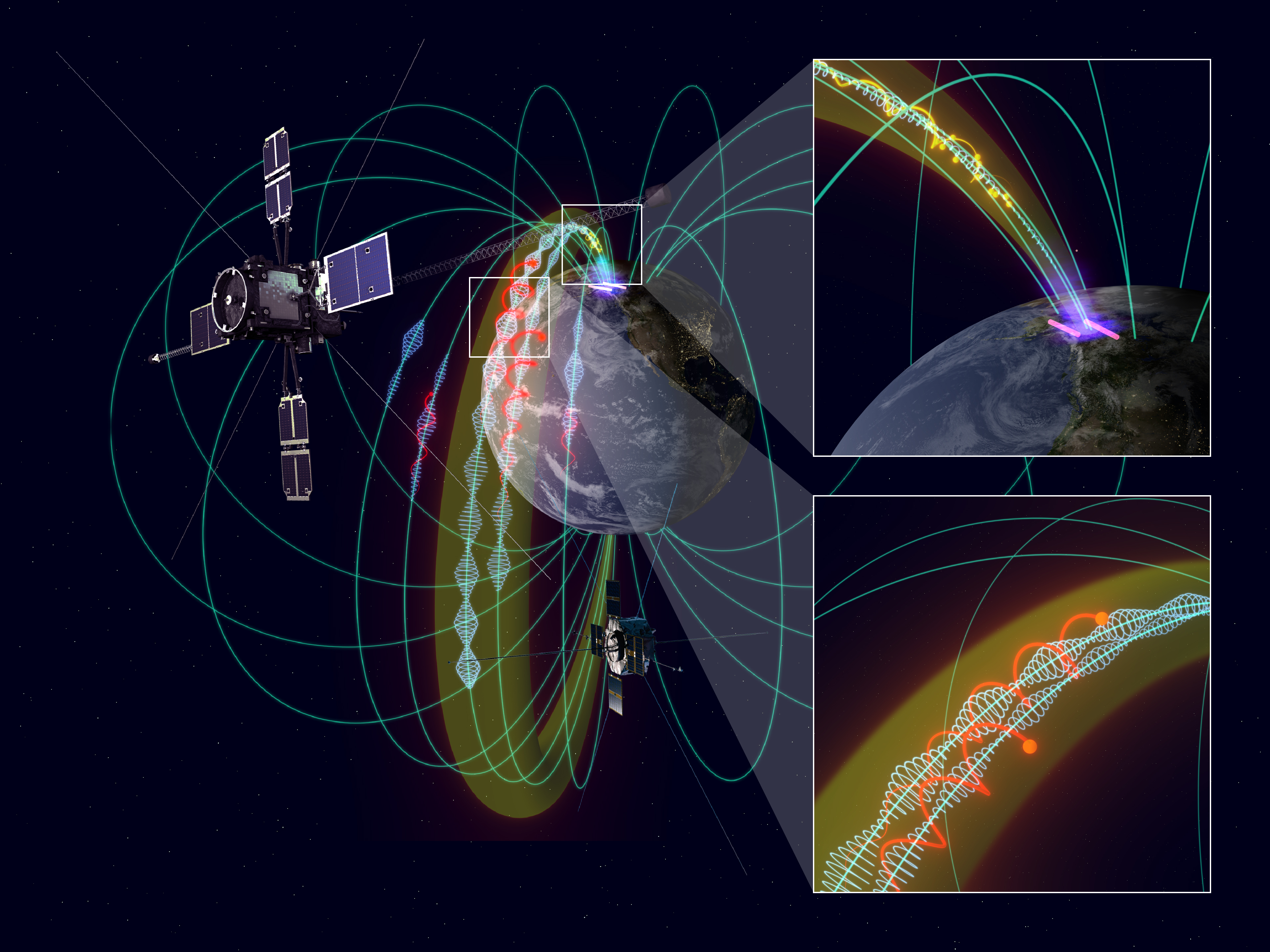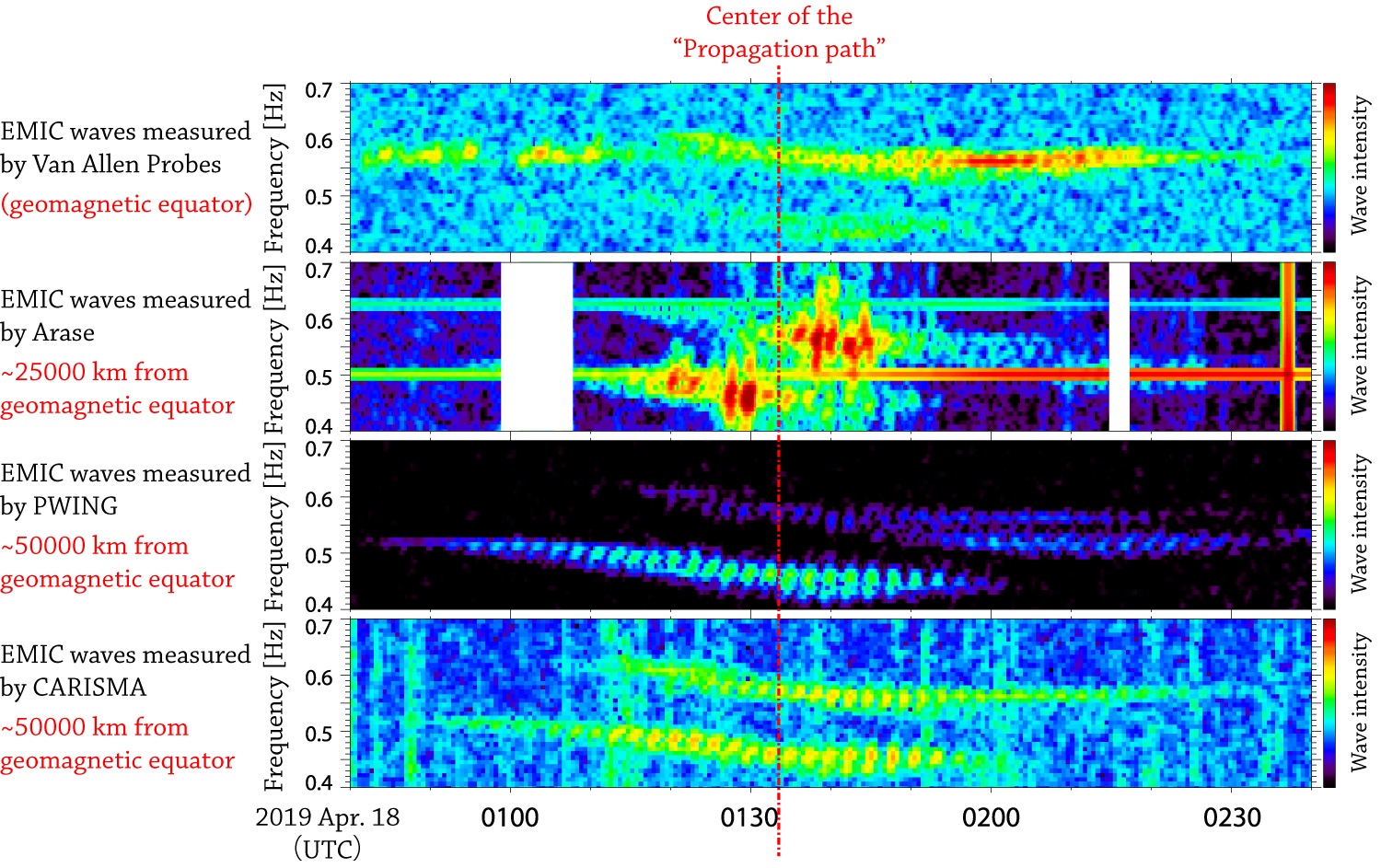Abstract: Using data on electromagnetic (EM) waves and plasma particles measured simultaneously via multiple satellites, an international collaborative research group has discovered the existence of invisible “propagation path” of EM waves and elucidated the mechanism by which EM waves propagate to the ground.
[Background]
It is known that various kinds of EM waves occur naturally in geospace and cause variations in the plasma environment that surrounds the Earth via a physical process known as wave–particle interaction. In particular, when geospace storms occur due to disturbances of sun and solar wind, EM waves become more active, and variations of geospace environment sometimes, may cause damage to spacecrafts, expose astronauts to radiation, and cause terrestrial power grid failures. To understand variation in the plasma environment caused by EM waves in space, in-situ measurement has been performed in space using spacecrafts, such as the Japanese geospace satellite “Arase”.
As EM waves in space propagate far away from their origin, to correctly understand the effects of EM waves, it is crucial to understand where in space the EM waves are generated and how they are propagated. However, it has been difficult to unravel the origin of EM waves and the mysteries of how EM waves spread spatially using only single-point observation. “Electromagnetic ion cyclotron waves (EMIC waves),” which are the focus of this study, are an important class of EM wave in geospace that control variations in the geospace plasma environment. The source region of ion mode waves has a finite spatial extent, and generated EMIC waves are considered to propagate north to south along the geomagnetic field lines. The specific spatial size of the EMIC wave source region and the 3D aspect of how the propagation path is formed from space to ground are yet to be elucidated.
[Overview of the Results]
The international collaborative research group, linking observations from space using the Japanese “Arase” and US “Van Allen Probes”, with observations from the Japanese “PWING Project” and Canadian “CARISMA Magnetometer Array”, has successfully performed simultaneous observations of EMIC waves from different locations (Fig. 1). By comparing the observation data obtained from each location, it was clarified that only waves that exist in a straw-shaped “propagation path” are able to travel from space to ground. The Van Allen Probes near the geomagnetic equator and the PWING and CARISMA magnetometer on the ground observed the same EMIC waves, indicating the existence of a propagation path for the EMIC waves between space and ground. Arase observed the EMIC waves in the mid-latitudes and contributed to determining the spatial size of the propagation path (Fig. 2). Arase achieved high-quality EM wave measurements with the Plasma Wave Experiment (PWE) and Magnetic Field Experiment (MGF) instruments aboard the spacecraft, and the value of the Arase observation was significantly enhanced through the international collaboration.
The precise measurements of plasma particles obtained from “Arase” and the “Van Allen Probes” have also shown that EMIC waves energize thermal ions as they propagate along the “propagation path;” thus, they cause changes to the ambient plasma environment. It is also known that EMIC waves produce proton auroras, and the results of this study can be interpreted as clarifying the path taken by the energy that is the source of the proton aurora when propagating from space to the ground.
[Future Directions]
This study has clarified the “propagation path” for guiding EMIC waves from space to ground. By understanding where EMIC waves occur in space and how they propagate, it is possible to clarify the mechanism by which the space plasma environment change occurs simultaneously in the vast geospace. The findings of this study will contribute to improve the accuracy of space weather forecast. Further, members of the international collaborative research group are in charge of developing wave instruments aboard the BepiColombo/Mio for Mercury orbiter and the JUICE spacecraft (scheduled for launch in 2022) for Jovian system. Based on these results, we aim to elucidate the mechanism of EM wave generation and propagation on planets other than Earth, as well as move forward, toward a comprehensive understanding of space environment and contribute to space weather forecasting.

Figure 1. Image of the Multipoint Observation of the Straw-shaped “Propagation Path” of Electromagnetic Waves (Credit: ERG Science Team)

Figure 2. Results of multipoint EMIC wave measurement by Van Allen Probes, Arase, PWING, and CARISMA (Credit: Kanazawa University)
[Article]
Title: Multipoint Measurement of Fine-Structured EMIC Waves by Arase, Van Allen Probe A and Ground Stations
Journal: Geophysical Research Letters
Authors: Shoya Matsuda1, Yoshizumi Miyoshi2, Yoshiya Kasahara1, Lauren Blum3, Christopher Colpitts4, Kazushi Asamura5, Yasumasa Kasaba6, Ayako Matsuoka7, Fuminori Tsuchiya6, Atsushi Kumamoto6, Mariko Teramoto8, Satoko Nakamura2, Masahiro Kitahara2, Iku Shinohara5, Geoffrey Reeves9, Harlan Spence10, Kazuo Shiokawa2, Tsutomu Nagatsuma11, Shin-ichiro Oyama2,12, Ian Mann13
1 Graduate School of Natural Science and Technology, Kanazawa University, Kanazawa, Japan
2 Institute for Space‐Earth Environmental Research, Nagoya University, Nagoya, Japan
3 Laboratory for Atmospheric and Space Physics, University of Colorado Boulder, Boulder, CO, USA
4 School of Physics and Astronomy, University of Minnesota, Minneapolis, MN, USA
5 Institute of Space and Astronautical Science, Japan Aerospace Exploration Agency, Sagamihara, Japan
6 Graduate School of Science, Tohoku University, Sendai, Japan
7 Graduate School of Science, Kyoto University, Kyoto, Japan
8 Graduate School of Engineering, Kyushu Institute of Technology, Kitakyusyu, Japan
9 Space Science and Applications Group, Los Alamos National Laboratory, Los Alamos, NM, USA
10 Institute for the Study of Earth, Oceans, and Space, University of New Hampshire, Durham, NH, USA
11 National Institute of Information and Communications Technology, Koganei, Japan
12 National Institute of Polar Research, Tachikawa, Japan
13 Department of Physics, University of Alberta, Edmonton, AB, Canada
DOI: 10.1029/2021GL096488



 PAGE TOP
PAGE TOP